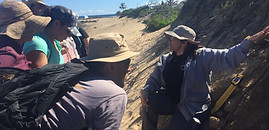
Project Directives
RESTORING NATURAL ECOSYSTEMS
On the Importance of Dunes
Coastal sand dunes operate as a defense against wind and wave action, mitigating the imminent impacts of climate change, specifically, increased storm surge and sea level rise.
The loss or relocation of sand dunes as sea level rises is unavoidable. When this change occurs slowly, natural and human communities in sand dune adjacent ecosystems have more time to find solutions and adapt. Today, climate change, sand extraction, off-road vehicles, trampling, and continued extreme storm events threaten the dunes. The current rate of sea level rise and the record-setting magnitude of extreme storm events, are causing sand dune damage at an expedited rate and adjacent ecosystems, as well as human communities, are being left vulnerable to more frequent extreme weather events. Though many of these dunes were badly damaged by the 2017 - 2018 storm season, those that were more resilient offer insights for future restoration actions.
Puerto Rico's Río Grande de Manatí river outlet in August 2017, before Hurricane María.

Río Grande de Manatí river outlet in September of 2017, during Hurricane María.

Our Plan for Success
We are building off lessons learned from extreme events to integrate climate adaptation planning to reduce impacts of storm surge and wave action to protect natural and human communities. We are leveraging post-hurricane information on where and why some dunes were more resilient during extreme events to prioritize key areas for restoration. We are using local knowledge of coastal change and the data collected by Dr. Isabel Rivera-Collazo and Para La Naturaleza’s citizen science teams to direct our community-based dune restoration efforts to those areas that are most vulnerable.
Study Site
The project area, which sits on the north-central coast of Puerto Rico (townships of Manati and Barceloneta), is characterized by ancient sand dunes separating the Atlantic Ocean from estuary and coastal wetlands and marshes. Sand dune restoration will be conducted at the Hacienda la Esperanza Reserve (Reserve), a 2,137 acre protected area managed by Para La Naturaleza. The Reserve is located at the mouth of an estuary and includes 10 unique ecosystems. Considered a national ecological treasure, the Reserve serves as a haven for many native, endemic and migratory species. These include rare and threatened birds such as the West Indian Whistling Duck and Red-Breasted Mergansers, various crabs, and endangered hawksbill, green, and leatherback turtles that use the beaches in front of the dunes for key nesting grounds.
Explore the Study Site
Para la Naturaleza recently created a virtual tour of the site where the DUNAS restoration is occurring. Now anyone in the world can explore the Hacienda la Esperanza and the coastal location of the DUNAS restoration from the comfort of your couch.
The virtual tour can be accessed here:






